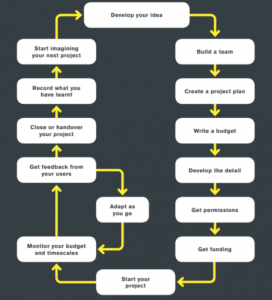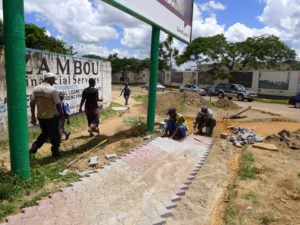
Financing models
Unfortunately, most cities have not prioritised children in their planning and design. We should move beyond designing our cities for the 30-year-old athletic person and think about the needs of our most vulnerable users: children, older adults, and the poor.
Gil Penalosa, founder and chair of the board 8 80 Cities
To fully integrate children’s health and mobility into planning, establishing sustainable sources for funding is essential. Yet in many cities, little funding is allocated to initiatives that improve mobility for children. Dedicated funding streams that explicitly prioritise the needs of children are urgently needed. In addition, innovative funding methods, including crowdfunding and other community financing options, can raise money for sustainable mobility initiatives.
In Nairobi, for example, walking accounts for 40 percent of daily trips, yet many parts of the city still lack proper pedestrian facilities. Responding to an urgent need to develop a safer walking and cycling environment, UN Environment’s Share the Road programme, with support from FIA foundation, worked with Nairobi City County to launch an Non-Motorised Transport (NMT) Policy for the city. The policy includes a first-of-a-kind commitment in Africa earmarking 20 percent of the transport budget to NMT.
5 KEY LESSONS
1. Compulsory investment in sustainable transport
Require infrastructure that accommodates pedestrians, bicyclists, and public transport users in all new construction projects.
2. Be opportunistic
Build footpaths and cycle tracks at reduced cost during other urban maintenance and road upgrades.
3. Leverage parking fees
Parking management can generate a sustainable stream of funding to support improved infrastructure for children’s mobility.
4. Crowdfunding
Harness modern communication tools to assemble monetary donations and generate public support for children’s mobility projects.
5. Calls for innovation
Competitive grant programs can maximize the investment of limited transport funds and leverage private sector contributions.
Best practices
Systematically dedicating road investment funds for NMT infrastructure has both symbolic and functional values. It highlights the fundamental importance of considering safety and the environment, and the mobility of all users. It also contributes to safer and more sustainable roads. Dedicated funding can take several possible forms, including setting aside a certain percentage like 10 per cent of the total funding budget for NMT infrastructure.
Local regulations can require infrastructure that accommodates pedestrians, bicyclists, and public transport users (complete streets) for all new construction and redevelopment. Such standards are critical to ensuring that a municipality supports children’s health and mobility by building out a network of sidewalks and child-friendly pedestrian facilities.
Case study: School Safety in Capital Project Planning
The school safety unit integrates school safety enhancements into New York City’s Department of Transportation’s (DOT) portfolio of city-wide capital projects. Capital projects are planned, funded and initiated by DOT and built by the NYC Department of Design and Construction (DDC) on DOT’s behalf. These projects take longer to construct and may include realignment of the curbs and sidewalks, and installation of curb extensions, medians and pedestrian refuge islands, in addition to infrastructure or utility work. The proposed improvements typically shorten crossing distances, organize traffic, discourage speeding and improve safety for all road users.

Strategic parking management can create a sustainable stream of funding to support improved pedestrian infrastructure. A successful technique for reducing transportation demand is to develop and “right-size” fees for on-street vehicle parking, while using revenue from the program to fund pedestrian improvements in the immediate area. This sends an important signal to the parking user about the value of parking provision. This technique also helps mitigate potential pushback against higher parking fees by making it obvious to the fee payer where their money is going (pedestrian improvements).
Exactions are contributions negotiated with individual development projects. They are typically used for specific on-site improvements in an area being developed, such as the dedication of rights of way and the construction of new roadway networks, traffic signals, sidewalks, and intermodal stations. Exactions are often in-kind contributions, but may be fees or contributions paid to the locality.
Communities can require that all new developments construct sidewalk and cycle facilities outside of the boundaries of the development when there is a likelihood that the new development will negatively impact the performance of the transportation network. This estimated impact can be powerful adjacent to schools where increased vehicular traffic secondary to the development creates an increased exposure to traffic violence and safety hazard to students. Developers can also be asked to provide a complete sidewalk or greenway connection to mitigate the effects of the new construction.
Successful development generates traffic and wear on the roadway system and other public services. An approach to mitigating those negative impacts is to assess a standard impact fee that is dedicated to improving the non-motorized transportation network in the community. Also known as development excise taxes, these fees pay for the new or expanded transportation facilities or services necessary to support a new development. They are similar to development exactions, except that the transportation improvements they support are commonly located outside of the specific property.
Inspired by the Safe Routes to Schools (SRTS) concept that began in the 1970s in Odense, Denmark, the United States developed a federal funding stream for these types of projects in 2005. SRTS programs use a variety of education, engineering and enforcement strategies to make routes safer for children to walk and bicycle to school as well as encouragement strategies to entice more children to walk and bike.
Similarly, government transportation officials can establish a state-sponsored grant program to improve access to schools. Total funding does not have to be significant, but it should be focused on increasing cycling and walking to schools by providing critical connections, improving strategic intersections, or launching programs to develop community support for future work.
Crowdfunding—lots of people giving small amounts of money—isn’t a new concept. Infrastructure and services have often been financed through public subscription. With modern communication tools and infrastructure, crowdfunding to generate public support for an idea has become more mainstream. Creating a funding campaign allows individuals and organizations to raise awareness and support, get validation for an idea, unlock grants and other funds as well as create a cadre of advocates for a particular project.
Communities are harnessing crowdsourcing platforms (e.g. Spacehive, Kickstarter, Indiegogo, Thundafund, CircleUp) to transform shared, civic, or publicly accessible spaces, either temporarily or permanently. The crowdfunding process is not only for raising money to support project development. It also plays an important step in generating public awareness for the mobility needs of children and suggests possible improvements.
Crowdfunding is often used as a means to unlock larger funds whether through match-funding or by leveraging larger donations from businesses who appreciate that the more backers a project has, the more positive exposure they’ll receive for funding it. Using crowd psychology the more backers your project has the easier it is to attract bigger backers as they are persuaded by the clear display of public support.
Small projects can yield a legacy of local involvement in long term change and help to build strong and resilient communities. These types of fundraising projects usually involve volunteers identifying a specific problem and raising money to explore and implement a specific solution. This organizing technique involves reaching out to the wider community, and encouraging people to get involved in their local area.
Community-led fundraising can leverage partnerships with media, nonprofit groups, and local PR firms to amplify the message of improved children’s health and mobility and rally their networks to collective action. Effective fundraising campaigns are adept at using social media to cultivate long-term relationships with donors and demonstrate the outputs of the process.

There are many examples of the private sector directly sponsoring road safety education initiatives. In particular, petroleum companies have been a major contributor to child road safety education through a number of initiatives.
In 1992, British Petroleum (BP) launched a teaching resource pack in the U.K., the unfortunately named ‘Living with Traffic,’ to support primary school road safety education. BP funded a road safety team that has toured schools in the U.K. for some 30 years teaching road safety awareness to primary school children through interactive theater.
Shell Oil has funded road safety education for primary school children in Germany, establishing the Deutsche Shell Youth Centre (DSYC) in 1950. Initially, the program funded fixed site traffic schools and provided equipment including, eventually, miniature cars. Later, mobile traffic education programs were developed, including equipment that could be taken to, and used in, individual schools. Using this model, DSYC provided equipment, and the state government or town/rural districts funded the program set-up and ongoing operation.
Corporate resources for public education are welcome, so long as these programs do not function as platforms to promote the use of private motorized vehicles and market the sale of petroleum products. Corporate social responsibility efforts and program sponsorship may be effective tools, but they should be calibrated to meet local needs. Children’s mobility educational programs should focus on all modes of mobility and in particular should encourage modes that are low-cost and have few negative environmental impacts.
Case study: Pave Kitwe Walkways Project
The Pave Kitwe project, an initiative started by Mayor Christopher Kang’ombe, aims to construct 400 km of footpaths across Kitwe, a mid-sized city in Zambia. The Mayor secured private sector funds to cover the cost of materials, while the city government supplies the labour. Corporate donors and individuals donated approximately ZMW 233,000 (USD 23,000) toward building high-quality pedestrian walkways.

A competitive grant program maximizes the investment of limited transportation funds and leverages private sector contributions. While a competitive grant program may represent a small portion of funding relative to a government’s total transportation funding, it can spark innovative solutions to transportation problems that can result in cost savings and better outcomes. Beyond the projects that are ultimately funded, the funding programs provide an orientation toward innovative and lower cost transportation that extends their reach. Other communities can see the success of children’s health and mobility focused projects, even if they are on a small scale.
While grant programs can play an important role in initial implementation, they are not always feasible as a long-term funding source.
Various “Microgrant” programs are emerging as alternate ways to fund planning studies and geospatial analysis. For example, in 2017 the Humanitarian OpenStreetMap Team (HOT) will provide grants (between $2,000 – $5,000 USD) to communities in Southeast Asia, South Asia, Latin America/Caribbean and Africa to carry out mapping projects. Developing a geospatial database of municipal assets (such as streets, sidewalks, plazas) can be a helpful tool to analyze children’s health mobility and understand the various affordances available to them.
Advances in transportation and communication have resulted in societies and economies that are more and more interconnected. As a result, countries in need of financing can look to expatriate citizens in wealthy countries for support. African countries are exploring diaspora bonds, remittances and foreign direct investment, as sources of infrastructure funding.
Diaspora bonds have promising potential for economic growth, but they are not without challenges. Ethiopia’s 2008 attempt to utilize diaspora bonds was unsuccessful. However, Kenya has marketed infrastructure bonds to retail investors, including from the diaspora. Most recently, Nigeria has successfully raised funds through diaspora bonds and has considered doubling its initial USD 100 million issuance.
A major factor in the success of diaspora bonds is a country’s ability to raise low-cost capital through patriotism. Expatriates can overlook many shortcomings of the financial stability of a country when they are helping boost their home country’s economic growth. The World Bank Migration and Development Brief reports remittances from 232 million international migrants are expected to reach $516 billion in 2016.
